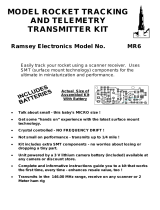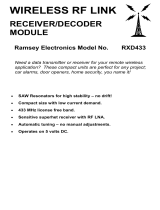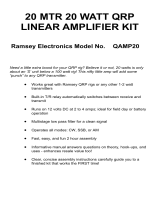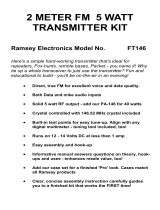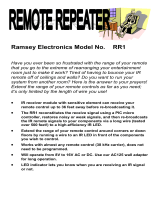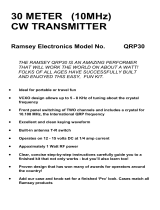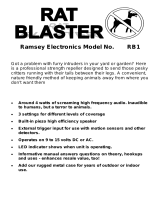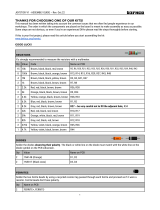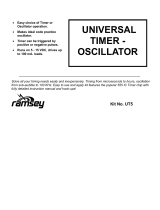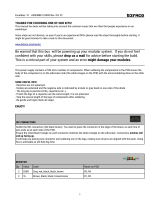Page is loading ...

RRW1A • 1
Ramsey Electronics Model No. RRW1A
Have you ever been frustrated with the range of your remote
controls? Tired of having to bounce your IR remote off of
ceilings and walls? Do you want to run your system from
another room or floor? Here is the answer to your prayers!
Extend the range of your remote controls through walls, around
corners, and even from outdoors!
• IR Receiver module with sensitive element can receive your
remote control’s signal up to 36 feet away before re-broadcasting
it wirelessly!
• The separate receiver (RRW1B) reconstitutes the radio signal
using a PIC micro-controller to restore noisy or weak signals and
then re-broadcasts the IR remote’s signal to your components via
a wired high-efficiency IR LED.
• Extend the range of your remote control to greater than 100 feet
wirelessly beyond the receive range of the IR sensor. Greater than
300 feet with a directional antenna pair (available separately).
• Works with almost any remote control (38 kHz carrier), does not
need to be programmed.
• Operate from 8V to 16V AC or DC. Use our AC125 wall adapters
for long operation.
• LED indicator lets you know when you are receiving an IR signal
or not.

RRW1A • 2
RAMSEY TRANSMITTER KITS
• FM100B Professional FM Stereo Transmitter
• FM25B Synthesized Stereo FM Transmitter
• MR6 Model Rocket Tracking Transmitter
• TV6 Television Transmitter
RAMSEY RECEIVER KITS
• FR1 FM Broadcast Receiver
• AR1 Aircraft Band Receiver
• SR2 Shortwave Receiver
• SC1 Shortwave Converter
RAMSEY HOBBY KITS
• SG7 Personal Speed Radar
• SS70A Speech Scrambler
• BS1 “Bullshooter” Digital Voice Storage Unit
• AVS10 Automatic Sequential Video Switcher
• WCT20 Cable Wizard Cable Tracer
• LABC1 Lead Acid Battery Charger
• IG7 Ion Generator
• CT255 Compu Temp Digital Binary Thermometer
• LC1 Inductance-Capacitance Meter
RAMSEY AMATEUR RADIO KITS
• DDF1 Doppler Direction Finder
• HR Series HF All Mode Receivers
• QRP Series HF CW Transmitters
• CW7 CW Keyer
• CPO3 Code Practice Oscillator
• QRP Power Amplifiers
RAMSEY MINI-KITS
Many other kits are available for hobby, school, Scouts and just plain FUN. New
kits are always under development. Write or call for our free Ramsey catalog.
RRW1A1 KIT INSTRUCTION MANUAL
Ramsey Electronics publication No. MRRW1A Rev 1.1
First printing: January 2002 MRW
COPYRIGHT 2002 by Ramsey Electronics, Inc. 590 Fishers Station Drive, Victor, New York
14564. All rights reserved. No portion of this publication may be copied or duplicated without the
written permission of Ramsey Electronics, Inc. Printed in the United States of America.

RRW1A • 3
RRW1A WIRELESS REMOTE
REPEATER KIT (Transmitter)
Ramsey Publication No. MRRW1A
Price $5.00
TABLE OF CONTENTS
Introduction ............................................4
Circuit Theory ........................................5
Learn As You Build ...............................7
Parts List ...............................................9
Assembly ............................................. 10
Testing .................................................14
Using the RRW1 Pair ..........................15
Schematic ............................................16
Parts Layout Diagram .........................17
Troubleshooting ..................................18
Warranty ..............................................19
KIT ASSEMBLY
AND INSTRUCTION MANUAL FOR
RAMSEY ELECTRONICS, INC.
590 Fishers Station Drive
Victor, New York 14564
Phone (585) 924-4560
Fax (585) 924-4555
www.ramseykits.com

RRW1A • 4
RRW1A INTRODUCTION
Welcome to the RRW1A kit (and if you don’t have the time, the wired and
tested version). Let’s take a moment to help you understand the basic workings
of IR remote controls and how the RRW1 pair works. This will better help you
understand what you are about to build. As simple as it may look, the RRW1
system is one of the best remote repeaters money can buy thanks to some
specialized technology we have added to restore normally unusable signals.
We will get more into that in the circuit description section.
The RRW1A and RRW1B system is used to extend the normal range of your
IR remote controls. The RRW1A receives the signal from your IR remote
control, converts it to an RF signal and then transmits it over the air. The
RRW1B receiver then receives the RF signal, reconstitutes it, and then sends it
to an IR LED to control your components.
Many stereo component manufacturers skimp on the IR receiver sections of
their equipment so the range of the remote is very poor. Have you ever thrown
your remote at the power switch because the darn thing wouldn't work from
across the room?!. This system helps to surmount that very problem. Another
common use is control your unsightly stereo components that are hidden within
a cabinet while you’re entertaining. The system allows your remote to control
these items while they are tucked away inside of a cabinet (or even locked
away for security reasons) with only the RRW1A exposed so it can relay the
information!
To use my house as an example, the stereo components are positioned
behind the couch and it is very cumbersome to have to reach way up with the
remote and beam it backwards in order to control them. Half the time it doesn’t
work even work for me because the batteries keep popping out of the remote (I
lost the remote’s back plate a long time ago in one of the many apartments I’ve
rented in the past, but that’s another story)! I don’t want to have to re-arrange
the room (that is the Wife won’t let me!) just so the remote will work better.
Instead I use the RRW1A in front of the couch someplace and have it relay the
signal back to the RRW1B to control the equipment for me.
To increase the effectiveness of this kit, we take advantage of a high-
sensitivity IR receiver element which claims on its specification sheet to work
up to 11 meters (about 36 feet) away from the remote control (that’s about 10.9
meters further than my VCR remote works!). Now I can truly atrophy on the
couch when my favorite program comes on and feel the pounds start packing
on! “Hey… another bag of chips when you get a chance Honey!!”

RRW1A • 5
RRW1 PAIR THEORY OF OPERATION
The RRW1A (transmitter board) may look quite simple but there is actually
quite a lot being done inside each one of the parts. Many individual compo-
nents are packed inside of the IR receiver part (U2) itself; so many in fact that
if it was built up with discrete components, it would never fit in this little kit
case. Inside of the part there is an IR detector diode, amplifier, AGC circuit,
bandpass filter, a peak-hold circuit, an integrator, comparators, and an output
amplifier. Heck, the part is a kit in itself! Just be glad it’s all in one nice module
and ready to go.
IR remote controls send out their data on a 38 kHz carrier much like the way
your FM radio does. By modulating the carrier signal with the data you want to
send, it is possible to increase the range of the transmission and decrease in-
terference from other IR sources like ambient light (the sun pumps out lots of
IR!!!). The modulation style used with remotes is called OOK (on off keying).
In a nut shell, OOK modulation means the IR LED is switched on and off at a
rate of 38 kHz in order to send the needed data. The digital data being sent
(ones and zeros) is composed of a certain duration pulse for a one and a dif-
ferent duration pulse for a zero. There are pauses with no carrier in-between
each one and zero data bit being sent for easy determination of the bit
boundaries. A common format for this type of data transmission is called
60/30 PWM. While this may sound complex, it really is not. Let’s take a closer
look.
PWM stands for Pulse-Width-
Modulation, meaning we
change the on-time of the LED
within a certain amount of time.
If we send data at a rate of 1
bit per second (bps), each bit
would take up a second of
sending time. To represent a 1,
the LED may be switched on
and off at 38 kHz for 60% of
the one second time frame (0.60 sec.) of it. For a 0, the LED will be switched
on and off at 38 kHz for 30% of the time (0.30 sec.) of the entire second.
0
1
0Sec 1Sec
0
1
0Sec 1Sec
IR Remote
Output
IR Detector
Output

RRW1A • 6
When the IR detector on the RRW1A (transmitter board) “sees” a 38 kHz IR
signal, the output of the detector goes low (it is inverted). When there is no 38
kHz signal present the output idles high. On the output of the IR detector you
won’t see the 38 kHz, just the data that the 38 kHz represents from your IR
remote control. This data from the IR detector is then used to switch on and
off a 433.42 MHz oscillator. Instead of switching an LED on and off at 38 kHz,
we are now switching an electrical field on and off at a rate of 433.42 MHz.
This acts as our new carrier frequency for the wireless part of the kit.
The oscillator section is a Colpitts style oscillator formed by Q2, C7, C8, R6,
and X1. The oscillator is turned on and off by Q3 through resistor R4 in accor-
dance with the received IR data. When a data pulse is detected by U1, its out-
put goes low pulling the base of Q3 low to turn it off. When Q3 turns off, the
collector (R3, R4, and Q3 junction) is pulled high so the needed bias voltage is
applied to R4 causing Q2 to turned on and begin oscillating with the surround-
ing parts. Turning Q2 on and off performs the on-off data keying (OOK modu-
lation) that we require to re-broadcast the IR signal.
The RRW1B (receiver board) has a specialized receiver chip which is also
set at 433.42 MHz. The receiver detects whether or not a 433.42 MHz field is
being broadcast and only sets its data output high if a signal is present. The
RRW1B will replicate the transmitted data by turning its data out pin on and off
at the received data rate. To re-send this data, we have to modulate a 38 kHz
carrier again in accordance with the data the IR detector puts out. By using a
micro-controller the data output from the IR detector can be sampled and a
Pulse Width Modulated (PWM) signal at 38 KHz can be generated in accor-
dance with the detected data.
By using this method with a micro-controller, we can add some intelligence
to the regenerated signal as well. The sample IR remotes we have looked at
send their data at a rate of around 2400 bits per second. This means that our
minimum pulse length for a zero should be 1/2400 x 0.30 seconds long (125
uS). Consider this example, let’s say that the signal from the IR remote is
weak and it fades out due to interference from some other IR source before
the data pulse is finished (i.e. 80 uS instead of 125 uS). The micro-controller
will continue to send the 38 kHz until 125 uS is up, not allowing the re-
transmitted signal to drop out the way the original source did. This error cor-
rection feature can be disabled in case you have a strange remote that is not
compatible (to this point we have yet to run across one that doesn’t work). Re-
move the jumper from J21 to disable this feature and have U21 blindly re-
create the data it sees.
Once the micro-controller on the receiver board has re-generated the 38 kHz
carrier (modulated by the data), its output is buffered by a transistor stage that
drives the high power IR LED used to control your equipment.
Wow! There’s a lot going on here!

RRW1A • 7
RAMSEY “LEARN-AS-YOU-BUILD” ASSEMBLY STRATEGY
Be sure to read through all of the steps and check the boxes as you go to be
sure you didn't miss any important ones. Although you may be in a hurry to see
the end results, before you switch on the power be sure to check all wiring and
components (especially capacitors) for proper orientation. Also check the board
for any possible solder shorts and/or cold solder joints. All of these mistakes
could have detrimental effects on your kit - not to mention your ego!
Kit building tips:
Use a good soldering technique - let your soldering iron tip gently heat the
traces to which you are soldering, heating both wires and pads simultaneously.
Apply the solder on the iron and the pad when the pad is hot enough to melt the
solder. The finished joint should look like a drop of water on paper, somewhat
soaked in.
Mount all electrical parts on the top side of the provided circuit board.The top
side is silk screened with the part number reference designators for easy
positing of the components. When a part is installed, it should be placed flat to
the board with the leads slightly bent on the backside of the board to prevent it
from falling out before soldering in position (1). The part is then soldered
securely to the board (2-4) and the remaining lead length is then clipped off (5).
Notice how the solder joint looks on close up, clean and smooth with no holes
or sharp points (6).

RRW1A • 8
This project will not work as well as you may wish if you just slap it together
without following good assembly techniques and all of the instructions. No
matter how clear we may think our manual is, if you have any questions give us
a call at the factory instead of jumping to conclusions. We will be happy to help
you with any problems may run into.
It is always good practice to mount the parts AS LOW AS POSSIBLE to the
board. A 1/4” lead length on a resistor not mounted close to the board can act
as an inductor or an antenna, causing all sorts of problems in your circuit. Be
aware though that there are stand up components in your circuit. They don’t
need to be squished to the board, but keep the portion of the resistor closest to
the board mounted right on the board.
For each part, our word "Install" always means these steps:
1. Pick the correct part value to start with.
2. Insert it into the correct PC board location, making sure the part is
mounted flush to the PC board unless otherwise noted.
3. Orient it correctly, follow the PC board drawing and the written directions
for all parts - especially when there's a right way and a wrong way to solder
it in. (Diode bands, electrolytic capacitor polarity, transistor shapes, dotted
or notched ends of IC's, and so forth.)
4. Solder all connections unless directed otherwise. Use enough heat and
solder flow for clean, shiny, completed connections.
Keeping this in mind, lets begin by sorting out our components and cross-
checking them against the parts list to make sure we have received everything.
NOTE TO NEWCOMERS: If you are a first time kit builder you may find this
manual easier to understand than you may have expected. Each part in the kit
is checked off as you go, while a detailed description of each part is given. If
you follow each step in the manual in order and practice good soldering / kit
building skills, the kit is next to fail-safe. If a problem does occur, the manual
will lead you through step by step in the troubleshooting guide until you find the
problem and are able to correct it.

RRW1A • 9
PARTS SUPPLIED WITH YOUR RRW1A (TRANSMITTER) KIT
Capacitors
1 2.2 pF ceramic capacitor (marked 2.2) [C7]
1 8.2 pF ceramic capacitor (marked 8.2) [C8]
3 47 pF ceramic capacitors (marked 47) [C1,4,6]
1 0.001 uF ceramic capacitor (marked .001 or 102 or 1 nF) [C3]
1 0.01 uF ceramic capacitor (marked .01 or 103 or 10 nF) [C2]
1 0.1 uF ceramic capacitors (marked .1 or 104 or 100 nF) [C5]
1 10 uF electrolytic capacitors [C9]
1 1000 uF electrolytic capacitor [C10]
Resistors
1 220 ohm resistor (red-red-brown) [R7]
1 270 ohm resistor (red-violet-brown) [R6]
1 470 ohm resistor (yellow-violet-brown) [R1]
1 2.2K ohm resistor (red-red-red) [R2]
2 4.7K ohm resistors (yellow-violet-red) [R3,8]
1 10K ohm resistor (brown-black-orange) [R5]
1 22K ohm resistor (red-red-orange) [R4]
Semiconductors
1 IR Sensor Module [U1]
1 1N4000 series rectifier diode (black with white band) [D2]
-Note that 1N4000-1N4007 diodes may used.
2 2N3904 NPN transistors (marked 2N3904) [Q3,4]
2 2SC2498 UHF NPN transistors (marked C2498 or C2570) [Q1,2]
1 78L05 5V voltage regulator (marked LM78L05ACZ ) [VR1]
1 Large Green LED [D1]
Miscellaneous Components
1 33 nH 4-turn coil [L1]
1 DPDT PC mount pushbutton switch [S1]
1 2.1 mm DC power jack [J1]
1 433.42 MHz saw resonator (TO-39 Metal 3-pin case) [X1]
1 6” piece of #20 buss wire

RRW1A • 10
ASSEMBLY OF THE RRW1A
Assembly of the RRW1A is straight forward but it does require some time
and patience. To get our bearings, we will start by mounting the power jack
and move on from there. It serves as a good reference point for the other
parts.
1. Install J1, the 2.1 mm power jack. Be sure to get a solid connection to
all three pads as this will have to take some mechanical strain during
normal use. Use ample solder (without ‘globbing’ it on of course).
2. Install R6, the 270 ohm resistor (red-violet-brown).
3. Install C7, the 2.2 pF ceramic capacitor (marked 2.2). C7 acts as the
feedback path for our “Colpitts” style oscillator. This capacitor combined
with the next one (C8) and the saw resonator (X1) make this circuit
oscillate at the required frequency. Note that this is one of the rare
exceptions to installing at 90 degree angles. This part is actually installed
at a 45 degree angle to keep lead lengths as sort as possible. This goes
to show how important it is to keep your lead lengths short! Even a small
amount of trace can introduce inductance that may prevent our oscillator
from working properly.
4. Install C8, the 8.2 pF ceramic capacitor (marked 8.2).
5. Install C3, a 0.001 uF ceramic capacitor (marked .001 or 102 or 1 nF).
6. Install L1, a 33 nH 4-turn inductor. Be careful not to distort or crush this
when installing it.
7. Install Q1, one of the 2SC2498 transistors (marked C2498 or C2570).
Pay close attention to the Parts Layout Diagram and the silkscreen on the
circuit board for proper orientation (the flat side is a good indicator). Right
next to Q1 is Q2 (another 2SC2498 transistor) so make certain to use the
correct mounting holes.
8. Install Q2, another 2SC2498 transistor (marked C2498 or C2570).
Again note the orientation of the flat side before soldering.
Transistor Q2 provides the amplification needed to keep the 433.42 MHz
RF oscillator going. Q1 and its surrounding parts form a special buffer stage
which isolates the antenna from the oscillator. If it wasn’t for this buffer stage,
the oscillator could stop working whenever things like your fingers or a metal
object are nearby. This pair working together forms a very stable oscillator
which resists a lot of external changes to maintain performance!
9. Install X1, the saw resonator (TO-39 metal case). This is the
component that determines the operating frequency of the oscillator by
interacting with the feedback capacitors surrounding Q2. Note the
silkscreen on the circuit board for proper orientation.

RRW1A • 11
10. Install R4, a 22K ohm resistor (red-red-orange).
11. Install C4, a 47 pF ceramic capacitor (marked 47). This capacitor works
with Q1 to isolate the antenna from the oscillator section. The capacitor
value of 47 pF was chosen because it looks like a direct short to ground at
433 MHz so any RF on the base of Q1 is removed!
12. Install C1, a 47 pF ceramic capacitor (marked 47).
13. Install C2, a 0.01 uF ceramic capacitor (marked .01 or 103 or 10 nF).
Both C1 and C2 are used as power bypass capacitors to keep RF signals
out of the power supply. While a 47 pF capacitor looks like a short at 433
MHz, a 0.01 uF ceramic capacitor does not. Why do we use a 47 pF right
next to this 0.01 uF ceramic capacitor? This bypasses the 433 MHz and
any other low frequency signal that could be present. It is a good practice to
bypass RF stages in this manner to remove any possible noise in the
system.
14. Install R1, a 470 ohm resistor (yellow-violet-brown).
15. Install R2, a 2.2K ohm resistor (red-red-red). R1 and R2 form a bias
network for Q1, which allows a certain amount of current to be available to
Q2 when oscillation begins. They also work in conjunction with C4 above to
isolate the oscillator from the antenna.
16. Install C6, a 47 pF ceramic capacitor (marked 47). This capacitor helps
to keep any 433 MHz signal from feeding back on our data input circuit.
17. Install Q3, a 2N3904 NPN transistor (marked 2N3904). Pay attention to
the flat side for orientation. This transistor is needed to invert the data
output of the IR detector. If you remember from the circuit description, the
output of the IR detector goes low when a signal is detected. We want to
transmit a signal whenever that output goes low so we need to invert the
low to a high to turn the oscillator stage on when the IR signal is seen.
18. Install R3, a 4.7K ohm resistor (yellow-violet-red).
19. Install JMP1 using a spare piece of component lead. Since this layout is
on a single sided board, some routes just couldn’t be performed without
adding this jumper.
20. Install R5, a 10K ohm resistor (brown-black-orange).
21. Install U1, the IR detector. Pay attention to the orientation and make
sure all leads are through the holes before soldering in place.
22. Install C5, a 0.1 uF ceramic capacitor (marked .1 or 104 or 100 nF).
This bypass capacitor reduces any noise on the power supply line just
before going into U1. We don’t want any noise here to give us false data
pulses!

RRW1A • 12
23. Install R8, a 4.7K ohm resistor (yellow-violet-red).
24. Install Q4, a 2N3904 transistor (marked 3904). This transistor is used
to amplify the small amount of current provided from the IR detector to a
large enough amount to drive the LED indicator. The LED will blink OFF
when a signal is seen, so it has a dual use of indicating power as well.
25. Install D1 (the Green LED).
This LED will blink OFF when the
IR detector sees data to let you
know that and IR signal has been seen and is being re-sent. D2 is polarity
sensitive since it is a diode so correct orientation is a must! Look at the
diagram above. The long leg of the LED indicates the Anode while the
shorter is the Cathode; the Cathode is the larger fat section that you can
see inside of the LED case. The Cathode is also indicated by the flat side
of the LED body if you look at it on end. Note the silkscreen on the board
and the Parts Layout Diagram show the flat edge of the LED for proper
positioning. Orient the LED so its flat side is the same. Do NOT mount the
LED flush to the board. Mount the LED as high as possible, about 1 1/4”
off of the board. The LED will eventually be bent over to peek out of the
front of a the case.
26. Install R7, a 220 ohm resistor (red-red-brown).
27. Install C9, a 10 uF electrolytic capacitor (small cylindrical component
coated with plastic and marked 10). Electrolytic capacitors are polarized
with a (+) and (-) lead and must be installed in the correct orientation.
Ordinarily, only the negative side is marked on the capacitor body with a
dark band and the (-) sign clearly shown. The PC boards will usually show
the (+) hole location. Use care to ensure proper polarity. See the Parts
Layout Diagram for proper placement. The capacitor should fit snugly
down to the PC board.
28. Install VR1, the 78L05 voltage regulator. Make sure the flat side of this
component is in the same orientation as shown on the silk screen and
Parts Layout Diagram. This part works by “smoothing” out any ripple that
may reside on the non-regulated input side of the part. It also allows you
to run this kit from a wide range of input supply voltages.
29. Install D2, the large 1N4002 regulator diode. If you are using an AC
power supply, this diode helps to convert the AC source voltage to pulsed
DC. C10 (which we install last for mechanical reasons) accumulates the
pulsed DC and smoothes it out so that regulator VR1 can process it the
rest of the way and provide us with a clean power source. If a DC power
source is used, the diode provides you with reverse power protection
should the supply not be setup with a positive tip like it should.
30. Install S1, the power switch. Solder one pin and make sure the switch
A
K

RRW1A • 13
TESTING THE RRW1A
Method #1
To begin testing the RRW1A you will need the following items:
AC Power supply between 6 and 12VAC or..
DC power supply between 8 and 14VDC.
A known functional IR remote control
Apply power to J1 and turn on the power switch (S1). The Data LED (D1)
should turn on and stay on, acting as a dual purpose power LED. The only
time D1 will turn off (or become very dim) is when an active 38 kHz data
stream is being received by the IR detector module (U1).
A quick functional test is to verify that the Data LED flashes off when you
point an IR remote at the IR sensor (U1). The flashing indicates that the data
from the remote control is being seen.
If you wish to go one step further and you have a radio which can tune to
433.42 MHz (AM mode), you can verify that the oscillator is working. Tune the
radio for 433.42 MHz and turn on the RRW1A power switch (S1). Press a but-
ton on the remote control and you should be able to hear the data stream be-
ing transmitted from the RRW1A. The selectivity of your monitoring radio may
be much tighter than that of the receiver (RRW1B) so you may need to tune
up or down a bit on the dial to find the signal. Adjusting the frequency of the
transmitter for exactly 433.42 MHz will not be needed due to the front end
characteristics of the mating RRW1B series receivers. This makes life easy!
is straight and flush to the board. Then solder the rest before moving on.
31. Install C10, the large 1000 uF electrolytic capacitor. Double check the
orientation before soldering as this is especially critical with this
component. Follow the same guidelines you used to install C9!
32. Install ANT1, the 6” piece of buss wire. Solder the wire in place where
the circuit board has been marked “ANT1” for easy identification. Use a
ruler and trim off any extra wire if longer then 6” (5 3/4” to 6” works great).
FINISHED!! 32 steps may not seem like a lot but we are done with the
transmitter! You should go back through the steps before moving on and
check for proper orientation of devices before plugging in the power however.
This will prevent damaging anything by accident. Check capacitors for
orientation, the IC, and also the rectifier diode as preventative measures.

RRW1A • 14
Method #2
If you are not lucky enough to have a radio that can receive 433.42 MHz, the
next best way to check the RRW1A transmitter is by using an RRW1B re-
ceiver. You just need to have faith that you have assembled everything cor-
rectly up to this point! It can be very difficult to troubleshoot this item without
some good equipment so we will have to do it the old fashion way if it comes
to it. See the troubleshooting section for more details if you need to.
Here is what you will need:
An IR remote and the equipment it works with (cable box, stereo
system, or something similar).
A working RRW1B (receiver).
Two “wall wart” power supplies, one for the RRW1A transmitter
and one for the RRW1B receiver.
Begin by setting up the transmitter and receiver where you would like to use
them. The receiver is usually set on top of the components you wish to control
with the IR LED positioned so that it will beamed downward into the face of
the components where their IR sensors are located. The transmitter can be
set up wherever you are planning on using the remote control. For now, keep
it in the same room so you can see the Data LED on the front panels of both
units. Keep in mind that you do not want your remote control directly activating
the target equipment without being repeated through the RRW1 system first!
Turn on the power to both the receiver and transmitter. The Data LED on the
transmitter (RRW1A) should be on by default while the Data LED on the re-
ceiver (RRW1B) should be off. If the Data LED on the receiver is flashing or
continually on (without sending data through the transmitter of course), R20
(on the receiver) will need to be re-adjusted. Use a small screwdriver to adjust
R20 on the RRW1B if needed so that the LED just turns off. It may slightly
flash a little due to noise in the receiver being seen on the data line. Adjust
R20 until the LED just goes out and stays out; leave it at this setting. The best
possible adjustment is where the LED is out, but it is really close to the point
where it turns on again. You have successfully adjusted the squelch setting!
With the receiver properly tuned, aim the remote at the transmitter and press
a button. The Data LED should flicker on the transmitter from the remote’s
data. The Data LED on the receiver should begin blinking at the same time.
This means your wireless link is working!
Now just test some functions on the remote to see if it controls your device
and your off to the races! Try moving the transmitter to another room now and
see if everything still works. You should get a fairly decent range that should
more than enough to cover most people’s homes.

RRW1A • 15
USING THE RRW1
There really is no secret to using the RRW1 system. You primarily want to
position the RRW1B in the stereo cabinet or on top of your components so the
antenna can stick up. The RRW1A should be placed so that the IR sensor can
see your remote control’s IR signal and is in the location you want your remote
to work from. Put the receive on top of a book shelf or even between books to
hide it. I am sure you will think of something clever.
The real trick is how to get the IR LED on the RRW1B mounted so that all of
your components can its relayed signal. The optimum way would be to use a
coat hanger to suspend the LED out in front of the components and have it
shine back at them. Unfortunately this is quite ugly and could poke out too far
to be able to close the doors of a cabinet. If it will be inside of a cabinet, you
can conveniently bounce the light off of some small pieces of aluminum foil
mounted to the back sides of the doors and reflect the IR down to the compo-
nents. With a little work, you could even permanently mount the IR LED on the
inside of one of the doors. This configuration might take a bit of wire however
in order to discreetly snake the hook-up from the RRW1B receiver down
through the cabinet and along the door. So far the longest piece of wire we’ve
tried was about 750 feet… no problem!! However the output of the IR LED is
intense enough that it will probably activate all of your components just by re-
flecting around inside of the cabinet.
If you do not have doors to reflect the RRW1B’s emitted IR signal from, try
angling the light from above somewhere. This usually works well also. In my
case my components are currently sitting on a coffee table behind the couch
until we save enough pennies to buy a cabinet. In this case I can actually
mount the IR LED in a crack in the couch to aim it at the components. This
worked out quite well for me since the IR LED is now all but hidden from view.
Hopefully it doesn’t get yanked out the next time I’m scrambling through the
cushions for change to tip the pizza delivery guy!
To determine the maximum range of the entire system, add up all of the indi-
vidual component ranges that make up the entire system. Your remote’s sig-
nal can be picked up by the IR receiver (RRW1A) up to 36 feet away. It can
then broadcast that signal with the included antenna more than 100 feet. Now
run the IR LED emitter wire from the RRX1B as long as you like up to 300 feet
or so (I’ve used up to 750 feet while testing!). The output of the IR LED will
then span another 20 feet to give you over 450 feet more of extended range!
Change the stock whip antennas to one of our 433 MHz directional antennas
(RMZ# 4004 or LPY41) and you may be able to reach 1/4 mile or more! I
can’t imagine a scenario where you would want to do that, but it can be done.
Notice how the ground area on the bottom side of the circuit board near the
antenna position has been left open for your to attach the ground shield of the
coax should you choose this optional configuration.

RRW1A • 16

RRW1A • 17
RRW1A PARTS LAYOUT DIAGRAM

RRW1A • 18
TROUBLESHOOTING GUIDE
PROBLEM: The green Data LED does not light.
SOLUTION: 1) The LED (D1) may be installed backwards. Re-check its orien-
tation as described in the assembly steps. 2) Check pin 3 of U1 for +5V. If you
have no power here, check the wall transformer to make sure the center lug is
positive and the ring is negative for a DC supply. The polarity is not a factor if
you are using an AC transformer.
PROBLEM: The green LED doesn’t flicker off when I aim my remote at it.
SOLUTION: You are trying to relay an IR remote that is modulated at some
other frequency than 38 kHz. There is a variety of ranges available, but 38
kHz is by far the most common. Most consumer components operate at 38
kHz. This system ONLY works 38 kHz carrier signal remotes.
PROBLEM: I’m using a radio tuned to 433.42 MHz and I can’t hear the remote
control’s signal being re-broadcasted.
SOLUTION: Check to make sure your radio is set to receive AM signals and
that your receiver isn’t so narrow you are missing the signal. Tune around a bit
and you will probably find it. If not, it’s possible you made a mistake during as-
sembly of the sections surrounding Q1 and Q2. Please check your work and
make sure components are mounted flush to the board.
PROBLEM: I just can’t make the darn thing work!
SOLUTION: Call Ramsey Support at 1-585-924-4560 and look at the warranty
information at the end of this manual.
Power Supply:
• AC supply = 6 to 12 VAC or DC supply = 8 to 16 VDC @ 100 mA (+ tip)
• Current draw with a 12VDC source averages about 20 mA (RRW1A).
Dimensions
:
• PCB size: 4.0” x 4.7”
• Max component height: 7/8”
Miscellaneous
:
• Works with any standard 38 kHz carrier IR remote.
• Max effective BAUD rate: 2400 bps – standard for remotes.
• IR receiver module has an effective pick-up range of 11 meters (36 feet!).
• Max IR LED (D22 of RRW1B) wire extension length: Unknown!! Tested
over 750 feet and still going!
RRW1A SPECIFICATIONS

RRW1A • 19
The Ramsey Kit Warranty
Please read carefully BEFORE calling or writing in about your kit. Most problems can be
solved without contacting the factory.
Notice that this is not a "fine print" warranty. We want you to understand your rights and ours too!
All Ramsey kits will work if assembled properly. The very fact that your kit includes this new manual
is your assurance that a team of knowledgeable people have field-tested several "copies" of this kit
straight from the Ramsey Inventory. If you need help, please read through your manual carefully.
All information required to properly build and test your kit is contained within the pages!
1. DEFECTIVE PARTS: It's always easy to blame a part for a problem in your kit, Before you
conclude that a part may be bad, thoroughly check your work. Today's semiconductors and passive
components have reached incredibly high reliability levels, and it’s sad to say that our human
construction skills have not! But on rare occasions a sour component can slip through. All our kit
parts carry the Ramsey Electronics Warranty that they are free from defects for a full ninety (90)
days from the date of purchase. Defective parts will be replaced promptly at our expense. If you
suspect any part to be defective, please mail it to our factory for testing and replacement. Please
send only the defective part(s), not the entire kit. The part(s) MUST be returned to us in suitable
condition for testing. Please be aware that testing can usually determine if the part was truly
defective or damaged by assembly or usage. Don't be afraid of telling us that you 'blew-it', we're all
human and in most cases, replacement parts are very reasonably priced.
2. MISSING PARTS: Before assuming a part value is incorrect, check the parts listing carefully to
see if it is a critical value such as a specific coil or IC, or whether a RANGE of values is suitable
(such as "100 to 500 uF"). Often times, common sense will solve a mysterious missing part
problem. If you're missing five 10K ohm resistors and received five extra 1K resistors, you can
pretty much be assured that the '1K ohm' resistors are actually the 'missing' 10 K parts ("Hum-m-m,
I guess the 'red' band really does look orange!") Ramsey Electronics project kits are packed with
pride in the USA. If you believe we packed an incorrect part or omitted a part clearly indicated in
your assembly manual as supplied with the basic kit by Ramsey, please write or call us with
information on the part you need and proof of kit purchase.
3. FACTORY REPAIR OF ASSEMBLED KITS:
To qualify for Ramsey Electronics factory repair, kits MUST:
1. NOT be assembled with acid core solder or flux.
2. NOT be modified in any manner.
3. BE returned in fully-assembled form, not partially assembled.
4. BE accompanied by the proper repair fee. No repair will be undertaken until we have received
the MINIMUM repair fee (1/2 hour labor) of $25.00, or authorization to charge it to your
credit card account.
5. INCLUDE a description of the problem and legible return address. DO NOT send a separate
letter; include all correspondence with the unit. Please do not include your own hardware
such as non-Ramsey cabinets, knobs, cables, external battery packs and the like. Ramsey
Electronics, Inc., reserves the right to refuse repair on ANY item in which we find excessive
problems or damage due to construction methods. To assist customers in such situations,
Ramsey Electronics, Inc., reserves the right to solve their needs on a case-by-case basis.
The repair is $50.00 per hour, regardless of the cost of the kit. Please understand that our
technicians are not volunteers and that set-up, testing, diagnosis, repair and repacking and
paperwork can take nearly an hour of paid employee time on even a simple kit. Of course, if we find
that a part was defective in manufacture, there will be no charge to repair your kit (But please
realize that our technicians know the difference between a defective part and parts burned out or
damaged through improper use or assembly).
4. REFUNDS: You are given ten (10) days to examine our products. If you are not satisfied, you
may return your unassembled kit with all the parts and instructions and proof of purchase to the
factory for a full refund. The return package should be packed securely. Insurance is
recommended. Please do not cause needless delays, read all information carefully.

RRW1A • 20
RRW1A REMOTE REPEATER KIT
Quick Reference Page Guide
Introduction ............................................ 4
Theory of Operation ..............................5
Parts List ...............................................9
Assembly .............................................10
Testing ................................................. 14
Using the RRW1 Pair ..........................15
Schem atic ............................................ 16
Parts Layout ........................................17
Troubleshooting ...................................18
RRW1A Specifications ........................18
Warranty ..............................................19
Price: $5.00
Ramsey Publication No. MRRW1A
Assembly and Instruction manual for:
RAMSEY MODEL NO. RRW1A
REQUIRED TOOLS
• Soldering Iron Ramsey WLC100
• Thin Rosin Core Solder Ramsey RTS12
• Needle Nose Pliers Ramsey MPP4 or RTS05
• Small Diagonal Cutters Ramsey RTS04
<OR> Technician’s Tool Kit TK405
ADDITIONAL SUGGESTED ITEMS
• Holder for PC Board/Parts Ramsey HH3
• Desoldering Braid Ramsey RTS08
• Digital Multimeter Ramsey M133
TOTAL SOLDER POINTS
80
ESTIMATED ASSEMBLY
TIME
Beginner .............. 1.5 hrs
Intermediate ........ 1.0 hrs
Advanced ............. 0.5 hrs
RAMSEY ELECTRONICS, INC.
590 Fishers Station Drive
Victor, New York 14564
Phone (585) 924-4560
Fax (585) 924-4555
www.ramseykits.com
/

